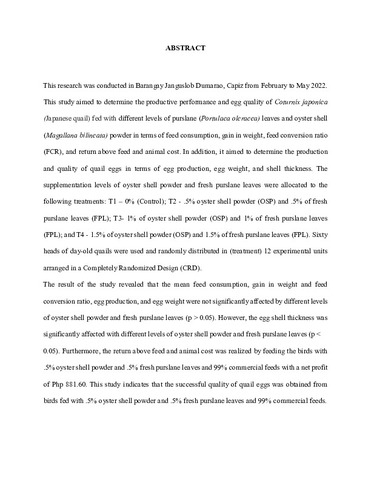Productive performance and egg quality of Quail (Coturnix japonica) fed with different levels of combined Oyster shell (Magallana bilineata) powder and fresh Purslane leaves (Portulaca oleracea L.)
| dc.contributor.advisor | Lago, Mario L. | |
| dc.contributor.author | Abogona, Melenia V. | |
| dc.contributor.author | Factor, Carlo Ed A. | |
| dc.contributor.author | Frac, Jerome Emman M. | |
| dc.contributor.author | Raymundo, Leo Berlyn S. | |
| dc.date.accessioned | 2024-03-20T01:52:24Z | |
| dc.date.available | 2024-03-20T01:52:24Z | |
| dc.date.issued | 2023-07 | |
| dc.identifier.citation | Abogona, M.V., Factor, C.E.A., Frac, J.E.M., & Raymundo, L.B.S. (2023). Productive performance and egg quality of Quail (Coturnix japonica) fed with different levels of combined Oyster shell (Magallana bilineata) powder and fresh Purslane leaves (Portulaca oleracea L.) [Undergraduate thesis, Capiz State University Dumarao Satellite College]. CAPSU Institutional Repository. | en |
| dc.identifier.uri | https://repository.capsu.edu.ph/handle/123456789/194 | |
| dc.description.abstract | This research was conducted in Barangay Janguslob Dumarao, Capiz from February to May 2022. This study aimed to determine the productive performance and egg quality of Coturnix japonica (Japanese quail) fed with different levels of purslane (Portulaca oleracea) leaves and oyster shell (Magallana bilineata) powder in terms of feed consumption, gain in weight, feed conversion ratio (FCR), and return above feed and animal cost. In addition, it aimed to determine the production and quality of quail eggs in terms of egg production, egg weight, and shell thickness. The supplementation levels of oyster shell powder and fresh purslane leaves were allocated to the following treatments: T1 – 0% (Control); T2 - .5% oyster shell powder (OSP) and .5% of fresh purslane leaves (FPL); T3- 1% of oyster shell powder (OSP) and 1% of fresh purslane leaves (FPL); and T4 - 1.5% of oyster shell powder (OSP) and 1.5% of fresh purslane leaves (FPL). Sixty heads of day-old quails were used and randomly distributed in (treatment) 12 experimental units arranged in a Completely Randomized Design (CRD). The result of the study revealed that the mean feed consumption, gain in weight and feed conversion ratio, egg production, and egg weight were not significantly affected by different levels of oyster shell powder and fresh purslane leaves (p > 0.05). However, the egg shell thickness was significantly affected with different levels of oyster shell powder and fresh purslane leaves (p < 0.05). Furthermore, the return above feed and animal cost was realized by feeding the birds with .5% oyster shell powder and .5% fresh purslane leaves and 99% commercial feeds with a net profit of Php 881.60. This study indicates that the successful quality of quail eggs was obtained from birds fed with .5% oyster shell powder and .5% fresh purslane leaves and 99% commercial feeds. | en |
| dc.language.iso | en | en |
| dc.publisher | Dumarao Satellite College, Capiz State University | en |
| dc.subject | Japanese quail | en |
| dc.subject | Japanese quail--Eggs | en |
| dc.subject | Eggs--Production (Japanese quail) | en |
| dc.subject | Purslane | en |
| dc.subject | Oyster shell | en |
| dc.subject | Japanese quail--Feeding and feeds | en |
| dc.subject.lcsh | Japanese quail | en |
| dc.subject.lcsh | Eggs--Production | en |
| dc.subject.lcsh | quail | en |
| dc.subject.lcsh | Japanese quial--Feeding and feeds | en |
| dc.title | Productive performance and egg quality of Quail (Coturnix japonica) fed with different levels of combined Oyster shell (Magallana bilineata) powder and fresh Purslane leaves (Portulaca oleracea L.) | en |
| dc.type | Thesis | en |
| dc.contributor.chair | Lago, Mario L. | |
| dc.contributor.committeemember | Ingalla, Leah A. | |
| dc.contributor.committeemember | Secretario, Ness Marie S. | |
| thesis.degree.discipline | Agriculture | en |
| thesis.degree.grantor | Capiz State University Dumarao Satellite College | en |
| thesis.degree.level | Undergraduate | en |
| thesis.degree.name | Bachelor of Science in Agriculture | en |
| dc.subject.agrovoc | Portulaca | en |
| dc.subject.agrovoc | oysters | en |
| dc.subject.agrovoc | quails | en |
| thesis.degree.department | Agriculture Department | en |
| dc.subject.scientificname | Coturnix japonica | en |
| dc.subject.scientificname | Portulaca oleracea | en |
| dc.subject.scientificname | Magallana bilineata | en |

